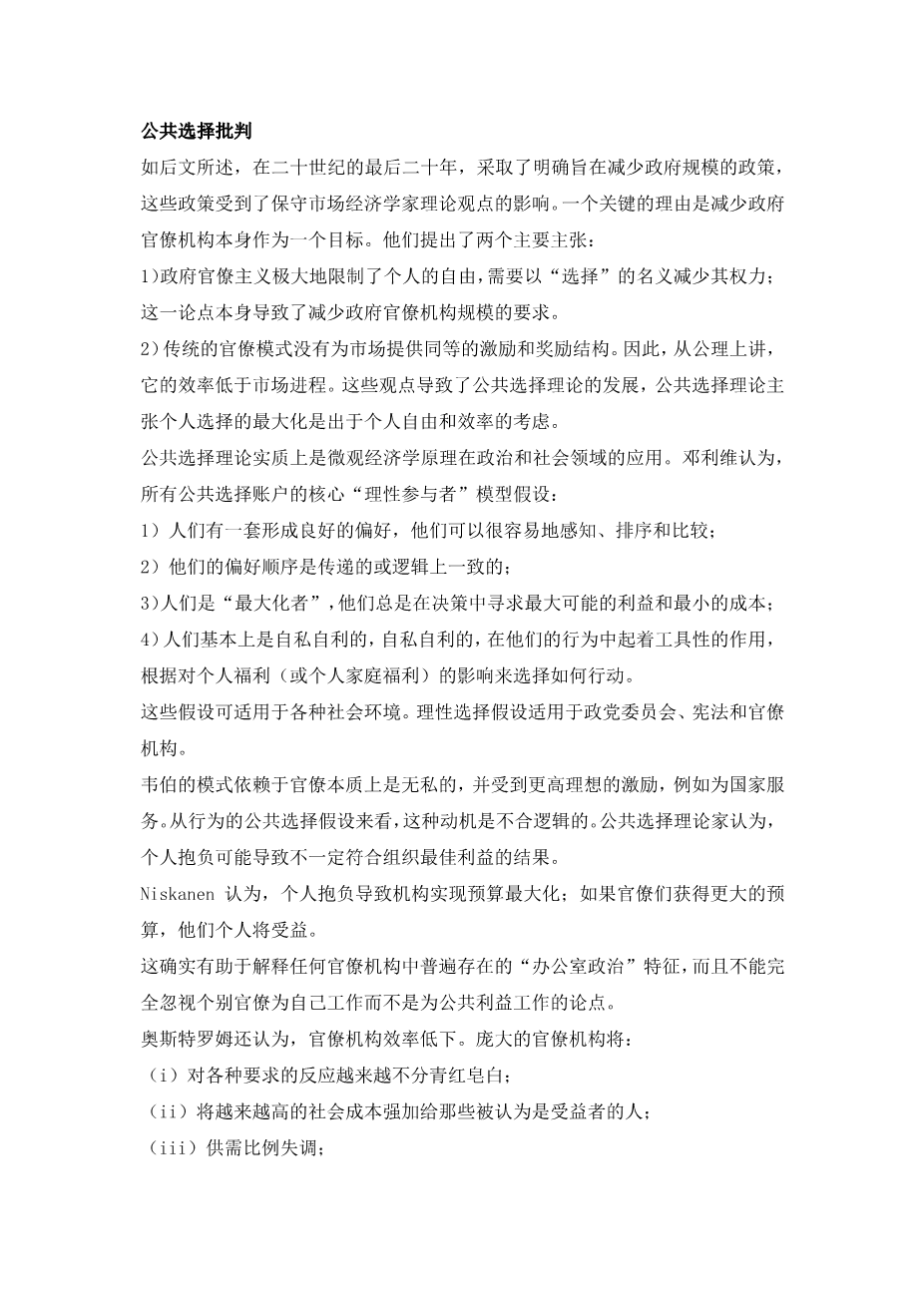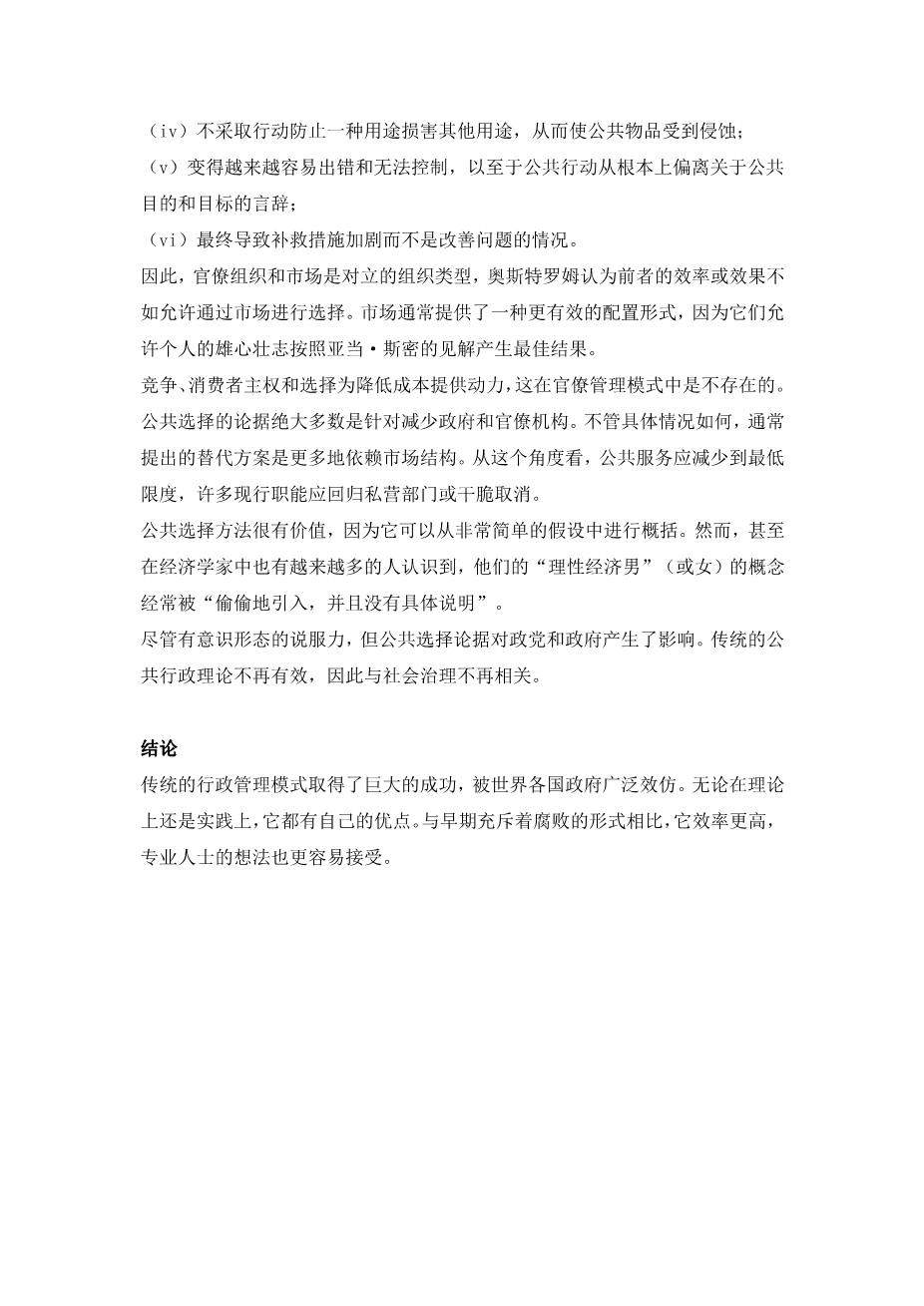The public choice critique
As argued later, the last two decades of the twentieth century saw the adoption of policies expressly aimed at reducing the size of government influenced by the theoretical arguments of conservative market economists. A key rationale was to reduce government bureaucracy as a goal in its own right. They made two main claims:
1) government bureaucracy greatly restricted the freedom of the individual and its power needed to be reduced in the name of choice;
This argument by itself led to demands to reduce the scope of government bureaucracy.
2) the traditional bureaucratic model did not provide an equivalent structure of incentives and rewards to those of the market. It was, therefore, axiomatically less efficient than market processes. These views led to the development of public choice theory, which argues for the maximization of choice by individuals for reasons of individual freedom and efficiency.
The theory of public choice is, in essence, the application of microeconomic principles to political and social areas. Dunleavy argues that the rational actor model at the heart of all public choice accounts assumes that:
1) people have sets of well-formed preferences which they can perceive, rank and compare easily;
2) their preference orderings are transitive or logically consistent;
3) people are maximizers who always seek the biggest possible benefits and the least costs in their decisions;
4) people are basically egoistic, self-regarding and instrumental in their behavior, choosing how to act on the basis of the consequences for their personal welfare (or that of their personal family).
These assumptions can be applied to a variety of societal settings. Rational choice assumptions were applied to political parties committees constitutions and bureaucracies.
Webers model relies on bureaucrats being essentially disinterested and motivated by higher ideals, such as service to the state. From a public choice assumption of behavior this kind of motive is illogical. Public choice theorists argue that individual ambition can lead to outcomes not necessarily in the best interest of the organization.
Niskanen argued that individual ambition leads to budget maximization by the agency; bureaucrats will benefit personally if they obtain a larger budget.
This does help to explain the pervasive feature of office politics found in any bureaucracy and the argument that individual bureaucrats work for themselves, instead of the public interest, cannot be totally discounted.
Ostrom also argues bureaucracies are inefficient. The very large bureaucracy will:
(i) become increasingly indiscriminating in its response to diverse demands;
(ii) impose increasingly high social costs upon those who are presumed to be the beneficiaries;
(iii) fail to proportion supply to demand;
(iv) allow public goods to erode by failing to take actions to prevent one use from impairing other uses;
(v) become increasingly error prone and uncontrollable to the point where public actions deviate radically from rhetoric about public purposes and objectives;
(vi) eventually lead to a circumstance where remedial actions exacerbate rather than ameliorate problems.
Bureaucratic organization and markets are, therefore, opposing types of organization and Ostrom sees the former as less efficient or effective than allowing choice through markets. Markets generally provide a more efficient form of allocation in that they allow for individual ambitions to lead to optimal out-comes following the insights of Adam Smith.
Competition, consumer sovereignty and choice provide incentives to lower costs, which are arguably absent in the bureaucratic model of administration.
Public choice arguments are overwhelmingly directed towards reducing government and reducing bureaucracy. The alternative usually put forward, regardless of the specifics of a given case, is to rely more on market structures. From this perspective, public service should be reduced to the bare minimum with many current functions returned to the private sector or simply abolished.
The public choice approach is valuable because it enables generalizations from quite simple assumptions. However, there is an increasing recognition even among economists that their notion of rational economic man (or woman) is too often introduced furtively and left under-specified.
Public choice arguments have had an impact on parties and governments, despite ideological persuasion. The traditional theories of public administration no longer worked and were, accordingly, no longer relevant to the governing of society.
Conclusion
The traditional model of administration was an outstanding success and widely emulated by governments all round the world. As both theory and practice, it had its good points. Compared to earlier forms that were rife with corruption, it was more efficient and the idea of a professional service was a great improvement on a personal or amateur one. It is argued here, however, that the problems of the model are now such that it can be regarded as obsolescent if not obsolete.
Traditional bureaucracy developed at a particular point of industrial development; its systems and technology were suited to an earlier age.
The theoretical pillars of public administration are no longe
剩余内容已隐藏,支付完成后下载完整资料


英语译文共 2 页,剩余内容已隐藏,支付完成后下载完整资料
资料编号:[262222],资料为PDF文档或Word文档,PDF文档可免费转换为Word
原文和译文剩余内容已隐藏,您需要先支付 30元 才能查看原文和译文全部内容!立即支付


